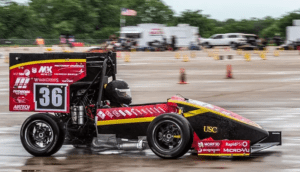With deep roots in the world of racing and motorsports, TotalSim has enthusiastically supported collegiate Formula SAE (FSAE) racing teams for many years. Formula SAE is a collegiate student competition hosted by SAE International (Society of Automotive Engineers) in which student teams design, build and test formula-style race cars. Through a partnership with AweSIM, the Ohio Supercomputer Center’s (OSC) modeling and simulation program for manufacturers, TotalSim provides academic teams with free access to our TS Auto app, approximately $5,000 worth of simulation tokens and engineering support.

TotalSim has sponsored 13 Formula SAE teams, the most recent of which is a “boomerang” team that came back to us in 2022 after trying out TS Auto a few years ago. The University of Southern California’s FSAE Racing Team has used TS Auto to design and develop their air ducts, rear wing, rear wing mounts and undertray, as well as running an aero map.
Just like commercial businesses, FSAE teams can use CFD to develop and optimize their vehicles by leveraging accurate aerodynamic data and running simulations. Without a tool like TS Auto, these academic teams are tasked with undertaking a complex CFD process using personal computers, painstakingly creating their own meshes without the benefit of automation and spending an inordinate amount of time learning the CFD process through trial and error. And, being comprised of students, the teams also have to contend with knowledge gaps that can occur when key team members graduate, taking that hard-won CFD know-how with them.
The TS Auto app allows FSAE teams to automate the entire CFD process so that users can receive valuable aerodynamic data on their vehicle without having to learn the complex CFD setup or spend time building meshes. The user simply uploads their geometry and inputs basic run conditions, and the app delivers a solution within 12-24 hours.
Ramakrishna Senthil, aerodynamics lead engineer for the USC FSAE racing team, notes that prior to using TS Auto, the team “conducted simulations through CFD software run locally on personal computers with in house meshes and physics conditions. Extensive amounts of time [were] required to set up these meshes for each new part design and ensure the solution reasonably [converged].”
With the ease of use and fast turnaround provided by the TS Auto app, Senthil says that “the team is more focused on understanding the entire vehicle’s aerodynamics and vehicle dynamic effects rather than expending significant amounts of time on CFD setup.” He also notes that “more intricate geometries can be modeled in [TS Auto] that were not otherwise possible with locally run CFD solutions due to compute power,” and that as a result, the team’s “CFD results are far more accurate and representative of the real world. The automated post processing is especially helpful as well, allowing quick comparisons between different geometries leading to faster design times.”
According to TotalSim US president Ray Leto, these benefits are exactly why TotalSim is eager to invest in Formula SAE teams. “It’s great to see the next generation of automotive engineers becoming familiar with CFD early in their careers, and not just on a theoretical level,” he says. “The fact that we can provide students with the chance to apply CFD to real world problems and expand their toolset is very rewarding.”
TotalSim looks forward to introducing more FSAE teams to CFD through its TS Auto sponsorship in the years to come. To learn more about our Formula SAE sponsorship and the teams already taking advantage of it, visit: https://www.totalsim.us/totalsim-fsae-sponsorship/
Related Content
The Strategic Advantage of Outsourcing in a Down Economy – Part 1
In-house or Outsourced Simulation for Product Development
Want to keep up with the news from TotalSim? Why not subscribe to our e-Brief?
